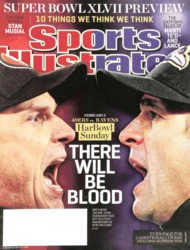
The Case for ... Homemade Swings
The era of the "beautiful swinger" in golf is on life support. That's the message that came out of the California desert last week, at the Humana Challenge. In fact, that's been the message for the first three weeks of the new season. A cliché of the PGA Tour is to say the swings today come off an assembly line. It's so untrue.
Dustin Johnson, 28, who won the first event of the year, the Hyundai Tournament of Champions, often drives it 340 yards and has a full-throttle swing that will wrench your back just looking at it. If his holds up, it'll be a miracle. He makes an impressive move. But it's not beautiful.
The following week Russell Henley, 23, won the Sony Open with a swing nobody would call artful, with his twisting head and lunging follow-through. His putting game is another matter, and that's why he birdied the final five holes to win by three.
At the Humana, Brian Gay, 41, won in a playoff, with a swing that is singularly undynamic and almost a relic. But most of the week belonged to Scott Stallings, the 27-year-old Tennessean with a country—not country club—swing, who entered the final round with a five-stroke lead.
Just before impact with the driver, his money club, Stallings has already cleared the ball with his lower body to such a degree that he cannot keep his front foot in position, with his hands barreling down at the ball and his clubhead pointing north. A millisecond after impact, his left foot is in the air and making a move toward third base.
"You couldn't teach that if you wanted to," says Bill Harmon, a golf instructor who caddied at the Humana for one of his students, Bill Haas.
Bubba Watson does about the same from the other side of the batter's box. "Bubba's front foot moves like Stallings's does but for a totally different reason," Harmon says of the lefthanded Masters champ. "At impact he has more of his body behind the ball than any good player we've ever seen."
Then, in a blur, Watson whips violently through the ball, too violently for the likes of his front foot. Barry Bonds did the same thing, especially when he was trying to pull the ball.
In the 1980s, using a driver made of persimmon, a steel shaft and a ball with a balata cover, Mac O'Grady was considered one of the Tour's beautiful swingers. Last week he was at the Humana, watching. The Watson slash, O'Grady says, was born in his equipment: a graphite shaft, a driver with a massive titanium head, a hard ball with a plastic cover. "If Bubba Watson had to play with the old equipment, he'd be caddying or shining shoes," O'Grady says.
The modern slashing swing offends O'Grady. Stallings played the par-5 543-yard 18th hole with a driver and a six-iron—flat ground, no wind—and made bogey to miss the playoff by a shot. That's not being in control of your golf ball. Control of your golf ball used to be what it was all about. O'Grady's swing loyalties are to Sam Snead, a swinger if ever there was one. O'Grady's friend Ken Venturi had similar devotion to the way Byron Nelson swung the club. Nelson was the ultimate swinger.
Last week, as representatives from the World Golf Hall of Fame were packing artifacts for his May induction, Venturi spoke with wistful admiration of old-time swingers, golfers who had rhythm and footwork that Fred Astaire would have admired. Brian Gay wouldn't fit in that category, but he's certainly closer to it than Scott Stallings.
Last weekend Mike Davis, the executive director of the USGA, was preparing for a visit to this week's Tour stop in La Jolla, to talk to players about the proposed ban on anchored putting. The great Tour putters of yesteryear—Jack Nicklaus, Ben Crenshaw, Tiger Woods—would never regard a stroke where the butt end of the putter sticks into one's navel as beautiful, but guys have been winning with it. And they'll continue to win with it, until anchored putting becomes illegal, a likely development in 2016, and good putting will look like a high art again.
"From talking to a lot of golfers of different eras," Davis says, "it always seems that they think the game was best when they were in their prime." There's wisdom in that.
Someday, maybe, the dancing-feet swings belonging to Bubba Watson and Scott Stallings will look classic. Until such time, they pay the rent.
Most of the week belonged to Stallings, the 27-year-old with a country—not country club—swing.
PHOTO
BEN MARGOT/AP

